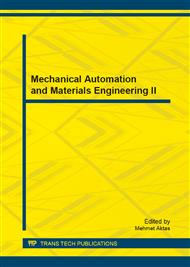p.312
p.317
p.321
p.329
p.334
p.339
p.344
p.349
p.354
Structural Design and Simulation of a Fully Decoupled Dual-Mass Micro-Gyroscope
Abstract:
This paper presents the operational principle, architecture design, resonance characteristics and FEM simulation of a new fully decoupled dual-mass silicon micro-gyroscope. The drive motion and sense motion of the micro-gyroscope studied in this paper are isolated from each other, mechanical quadrature error is thus dramatically suppressed due to the minimizing of undesired coupling between the drive and sense modes. Moreover,two identical single-mass gyroscopes are adopted and coupled with coupling beams to form a dual-mass micro-gyroscope, which provides enhanced common mode rejection in a differential mode. Finally, modal and harmonic analyses are implemented by FEM software, the simulation results obtained verify the good properties of the novel micro-gyroscope.
Info:
Periodical:
Pages:
334-338
Citation:
Online since:
June 2014
Authors:
Price:
Сopyright:
© 2014 Trans Tech Publications Ltd. All Rights Reserved
Share:
Citation:


